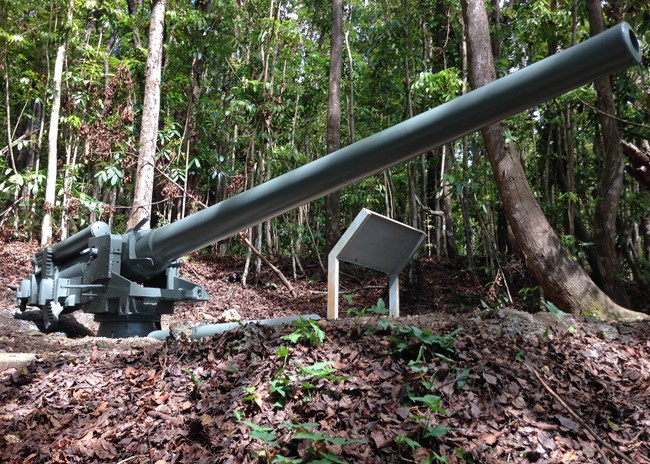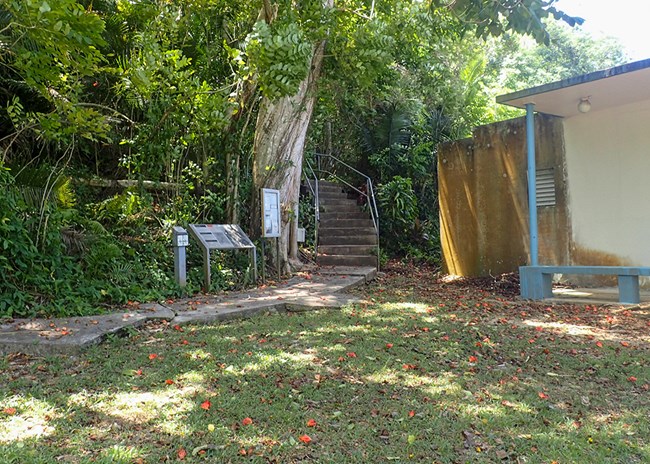
War in the Pacific National Historical Park During the last months of the Imperial Japanese occupation of Guam, Japanese defenders heavily fortified the island in preparation for the coming battle. Machine guns, artillery and mortar emplacements, and coastal defense guns were installed on the high ground near the coast. Heavy bombardment and intense fighting before and during the battle devastated the island, destroying homes, burning vegetation, and damaging the fortifications. Today, most of those fortifications are either gone or in ruins, but in the hills overlooking the village of Piti, three Vickers-type Model 3 140mm coastal defense guns still rest silently in a mahogany forest. They are the only guns in War in the Pacific National Historical Park that remain in their original emplacements. Things to Do and SeeHikingThe mile-long Piti Guns Trail leads hikers through a mahogany forest to three Japanese coastal defense guns. From the top of the trail, hikers are treated to a stunning view of Apra Harbor and the beaches below. Mahogany ForestThe coastal defense guns sit in the middle of a dense forest of mahogany (Swietenia macrophylla). Mahogany is not a native to Guam. These trees are actually native to Honduras! Mahogany trees were introduced to Guam by the Guam Agricultural Experiment Station (GAES). From 1908 to 1932, the United States Department of Agriculture (USDA) operated an agricultural station promoting American agricultural techniques and crops on the island. In the 1910s and 1902s, the ifit tree, the dominant native hardwood and official territorial tree of Guam, was becoming increasingly rare. GAES suggested introducing mahogany as a potential replacement. Originally, they experimented with West Indian mahogany but switched to the more commercially important Honduran mahogany. In 1928, 208 Honduran mahogany seedlings were planted on the hillside above the village of Piti. The mahogany flourished in Guam's warm, wet climate. Today, the mahogany forest is thriving. A 2018 study found that the grove covers 8.6 acres and is home to 516 mature mahogany trees. 
War in the Pacific National Historical Park World War II RemainsIn the months before W Day, three Vickers-type Model 3 140mm coastal defense guns were installed in emplacements in the Piti hills. They were meant to drive back American ships and landing craft attempting to land in Apra Harbor. Also known as 14cm/50 3rd Year Type guns, these were the most common coastal defense weapons used in the Pacific Islands. Each gun weighed more than 12,000 pounds, had a range of ten miles, and could fire six to ten round per minute. Two of the guns sit in earthen revetments, while the third gun is protected by a low walled concrete emplacement. Imperial Japanese troops forced CHamoru men over the age of twelve to join labor crews working on building fortifications. These guns were likely dragged into place by one of those labor gangs. Despite the forced labor, the hasty efforts to fortify the island were never fully completed. When the Americans arrived, the guns at Piti were not yet operational. There is no evidence they were ever fired. The 9th U.S. Marines, who captured the area on July 22, 1944, do not mention taking a battery of guns in their reports. 
War in the Pacific National Historical Park HoursThe Piti Guns Unit is open 24 hours a day, seven days a week. ParkingThe Piti Guns Unit parking lot is located next to the Assumption of Our Lady Church social hall. The trailhead is just behind the wayside exhibit at the base of the hill. DirectionsFrom airport, take Rte 10A to Marine Drive (Rte 1). Turn left and go approximately 8 miles. Turn left at the light onto Nimitz Hill (Rt. 6), then take an almost immediate left turn on Assumption Drive. Follow the road for about half a mile. Turn right onto Santa Ana St. just past the Assumption of Our Lady Church. Piti Guns Unit MapLearn More About the Piti Guns Unit
|
Last updated: March 17, 2025



